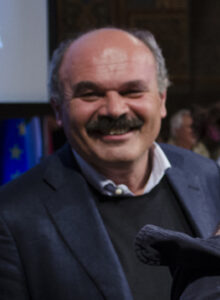
Oscar Farinetti, Wikipedia
On January 27, 2007 the genial and indefatigable Piemontese entrepreneur Oscar Farinetti opened his first mega food store of exclusively Italian food products, Eataly, in Torino; now they are in 46 locations in 15 countries with several more in the planning stages. In USA they’re located in Boston, Chicago, Dallas, Las Vegas, Los Angeles, New York, San Francisco, and the Silicon Valley. A decade later he opened FICO, the didactic food and agricultural park outside Bologna (hours Thursday-Sunday, 11 AM to 11 PM). In the fall of 2022, he founded E.ART.H, the acronym for Eataly Art House, with his son Francesco Farinetti, the president of the first “green” retail park “Green Pea” in Torino’s Lingotto neighborhood, once home to the largest FIAT car factory, and with cultural guru Chiara Ventura.
Created with the aim of making contemporary art accessible to the general public and celebrating its inclusiveness, beauty, and sustainability, E.Art.H. is located at Via Santa Teresa 12, in central Verona, in Eataly’s newest store. Its building, restored, after a long period of neglect, by architect Mario Botta, most famous for his churches and museums, had been Europe’s largest cold storage in the 1930s, with more than 10,000 square meters of refrigerated cells under a reinforced concrete dome.
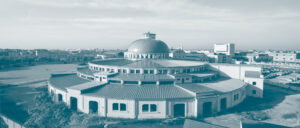
E.Art.H. exterior Courtesy of E.Art.H.
On display here until September 17 and not travelling afterwards (entrance free, from 12-20 PM Wednesday-Sunday; closed Monday and Tuesday), is “Photo & Food”, an exhibition of 125 photographs of food, depicting its social role, and its traditions during the past 80 years. The works are by 29 international photographers, all members of the Agency Magnum. Displayed in chronological and thematic order in five sections, the exhibition considers the social, economic and symbolic meanings of food, highlighting its inextricable connection to human life, both as nourishment and agriculture, as well as food’s connection to nature.
The first section From War to the Boom, all works in black and white, concern the immediate aftermath of the Second World War and the struggle to survive. Procuring enough food not to suffer from hunger was the daily preoccupation.
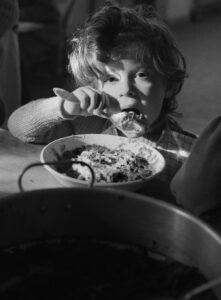
An Italian child in a center for refugees in Ticino, Switzerland, 1945. Copyright Werner Bischof/Magmum Photos
The second section The Food of Stars covers the 1950s and 1960s when once again food and prosperity was accessible to most people in Europe and the USA-the so-called years of the Economic Boom. The photographs here show conviviality and large gatherings and concentrate on photographs of the VIPS of those decades, for examples Marilyn Monroe, The Beatles, Ronald Reagan, Alfred Hitchcock, and Muhammad Ali, and their rapport with food at public events and at home. Also on display here are Phillipe Halsman’s shots of Salvador Dali’s surreal compositions and of Andy Warhol’s pop-art Campbell Soup cans, with food products idealized as art and when a product of nature became merchandise.
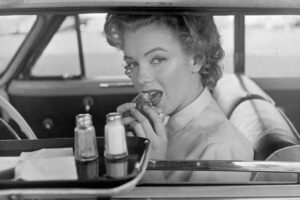
Marilyn Monroe, 1952, copyright Philippe Halsman/Magnum Photos
The third section From the Producer to the Consumer illustrates the food production chain-from the farmer to the market, beginning with Eve Arnold’s shots of bread-making in the Chinese countryside, to Ferdinando Scianna’s of making homemade tomato sauce in Bagheria near Palermo, to Alex Majoli’s of Palermo’s most famous market Ballarò, and ending with shots of supermarkets, the symbol of globalization.
The photos in Section Four, Extreme Food, cover genetically manipulated foods by Jonas Bendiksen and hydroponic cultivation by Alex Webb, the excessive use of plastic in packaging food by Cristina De Middel, and consuming junk food by Martin Parr. In contrast Jérôme Sessini’ series “Living the Good Life in VRMDZA”, a model of rural development and economic empowerment for Serbian villages” focuses on the desire to rediscover the rhythms and ways of life of the past, definitely a challenge for all of us to counterbalance a sector of life often controversial and dominated by technology and speed.
The photos in Section Five, The Sacred Table, concern the choice of foods we eat and how we prepare them during celebrations, both joyous and sad, of several world religions: Christianity, Islam, Judaism, and Buddhism. Noteworthy is Guy Le Querrec’s documentation of the preparation of Taan beer, drunk during the long funerary celebrations in Burkina Faso
A bilingual “catalog” (20 euros) is available from Eataly Art House’s online shop (www.eatalyarthouse.it), the first book published by E.Art.H..
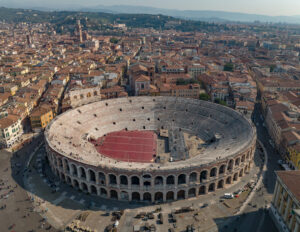
The Arena, Wikipedia
Besides E.Art.H. in Verona be sure to visit the Arena, the ancient Roman amphitheater completed in 30 AD, and the third largest in the world after Rome’s colosseum, and Santa Maria Capua Vetere near Naples; the medieval Casa di Giulietta, where Romeo’s fiancée lived and talked to her love from its balcony; the cathedral, dedicated to Verona’s patron saint San Zeno, the most ornate Romanesque church in northern Italy; the Museo del Castelvecchio, once a medieval military fortress in the center of town and now the municipal multi-media art museum, and the open-air market in Piazza Erbe.
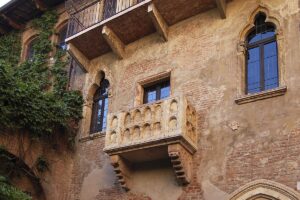
Juliet’s balcony
Speaking of food, for a special meal, choose between Casa Perbellini, Ristorante Il Desco, Ziga Bistrò, Special and Mr. Martini, La Chiusina, Corte Scaligera, Locanda 4 Ciacole, Osteria del Duomo, Osteria Osei, and L’Evangelista Ristorante & Enoteca. Verona’s specialties are risotto con tastasel (with salted minced pork), risotto all’Amarone (the strong local red wine), polenta, potato gnocchi, passtisada de Caval (horsemeat stew), lesso con la pearà (boiled meat with a bone marrow and bread crumb sauce), and the Christmas cake Pandora.
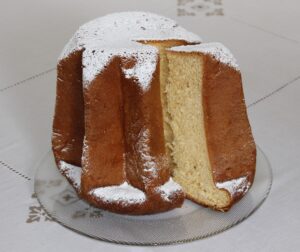
Pandora
If you need more time, especially if you’ve been lucky enough to book a ticket to an opera performance in the arena, book a room at pluri-awarded, if a bit pricey, Due Torri Hotel Baglioni. Right in the heart of medieval Verona, it’s one of Italy’s most eccentric hotels, with huge rooms each decorated and furnished in the style of a different historical era. Another choice is also centrally-located Hotel Accademia, a favorite with the opera-singers performing at the Arena.
